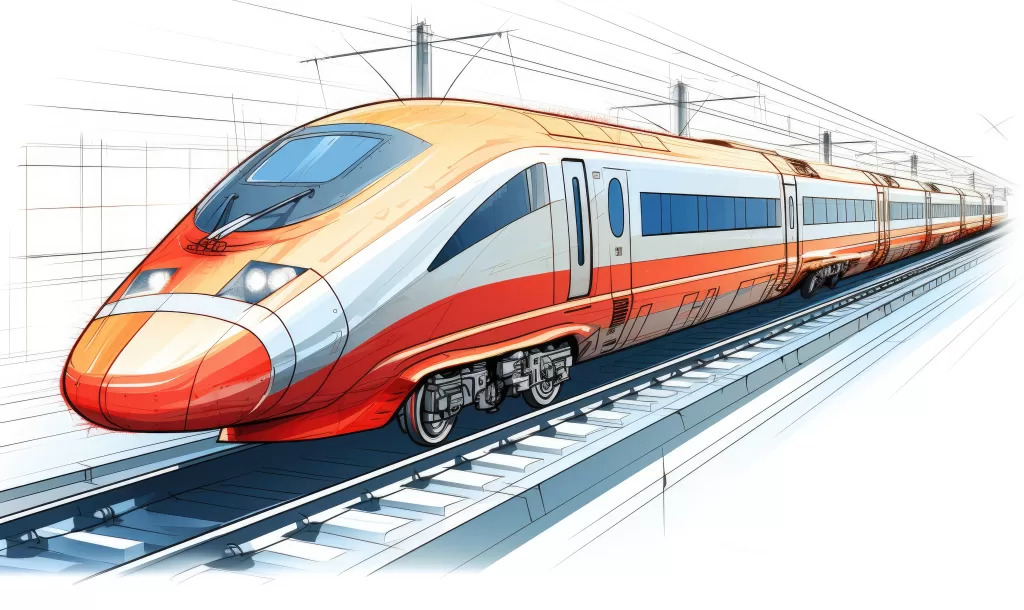Rail travel is one of the most energy efficient ways to travel, but trains still using a significant amount of energy which has a significant cost and environmental impact. While trains produce less than a quarter the greenhouse gas emissions per kilometre than cars, significant annual reductions of about 5% need to be made every year by 2030 in order to remain on track to net zero by 2050. Given that we sell carbon fibre, you may not be surprised to hear that carbon fibre has multiple applications in trains that could reduce rail emissions.
One way of reducing the financial cost and carbon intensity of train travel is to electrify trains and the lines they run on. Electrified rail reduces the cost of powering a train by about 45%, because electricity is cheaper than diesel and the trains do not have to carry the significant weight of their own fuel. The weight reductions also reduce the wear that trains cause to their tracks by up to 13%.
Rail electrification is one way to reduce operating costs and improve efficiency, but another is to reduce the weight of trains by using carbon fibre composites. There are several efforts to reduce the weight of trains through the use of carbon fibre, across all types of rail transport.
Carbon Fibre Applications on Trains
Bogies
One of the heaviest components of a train is the component that connects the wheels to the train body, called a bogie. These have been made from steel until now, but there are projects ongoing to replace these with carbon fibre composites. Talgo, the Spanish train manufacturer, has developed a carbon fibre bogie that weighs 50% less than an equivalent steel one that is being tested for their new generation of AVRIL high speed trains. Replacing the bogies with carbon fibre have contributed to a significant reduction in energy consumption for the trains. The weight saving innovations on the new AVRIL trains should reduce energy consumption by 30%.
Exterior Shells
Another major component is a train’s exterior shell. These are often made from steel and aluminium and may continue to be the best choice for mainline rail, but China’s CRRC has developed a carbon fibre metro train that is already operating in Guangzhou. The trains are designed to run up to 100mph, which is enabled in part by the 13% weight reduction that the carbon fibre allows for.
Weight reductions are particularly important on metro trains; iron oxide dust is released from the train wheels, tracks, and brakes as they wear down. This iron oxide has been found in the blood of metro users and is being investigated for its potential health risks, so reducing weight and therefore wear could reduce health risks for metro users by reducing the amount of iron oxide dust released in the tunnels.
Hydrogen Pressure Vessels
With the rapid development introduction of hydrogen technologies across so many industries in the effort to decarbonise, it was almost inevitable that this would spread to rail. Systems have been developed to replace diesel with hydrogen on trains, as an alternative to overhead cable electrification, with plans underway in more than half a dozen countries. Unsurprisingly, the hydrogen for these trains needs to be stored, with CFRP pressure vessels being a leading candidate. For example, Alstom’s Coradia iLint hydrogen-powered trains use Type IV pressure vessels developed by Xperion while he UK’s first hydrogen train, HydroFLEX, used Type IV pressure vessels from Luxfer Gas Cylinders.
Challenges to using carbon fibre on trains
There are strict regulations about what materials can be used on trains, in order to keep passengers safe in the event of a fire. Fire, smoke, and toxicity (FST) requirements must be considered when selecting fibres and resins to use in composite parts, which may need more consideration than would be required for a steel component. Another challenge is the higher upfront cost of carbon fibre; although lightweighting through carbon fibre should reduce operating costs for rail operators, the upfront cost of carbon fibre is higher than that of steel, which may be a barrier to the inclusion of carbon fibre in trains.


